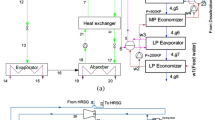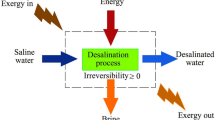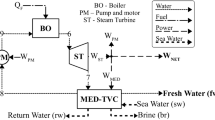Abstract
In this study, the energetic and exergetic analysis of a multi-effect desalination system with a thermal vapor compression desalination system has been numerically evaluated. For this purpose, the mass, energy, and exergy balance equations for the thermo-compressor, first effect as well as middle effects, and condenser have been developed. The effects of motive steam pressure and number of effects on yield, gained output ratio (GOR), performance ratio (PR) and irreversibility have been examined. Nanoparticles were used to improve the heat transfer properties at different stages. The highest rate of exergy destruction with 61.67% is concerned with thermo-compressor, owing to the large difference between the motive steam pressure and the entrained steam. The lowest exergy losses rate among the various components was 4.89% for the condenser, due to the fact that much of the final distillate steam entrained the thermo-compressor. As the number of effects increased from 1 to 7, the yield, GOR as well as PR, improved by approximately 590% and the irreversibility reduced by 1.88%. As the motive steam pressure increased from 400 to 1290 kPa, the yield decreased by 25.45% while the GOR and PR improved by 12.62 and 14.8%, respectively. From the second law viewpoint, irreversibility intensified by 16.11% which in turn diminished the second efficiency by 3.17%.














Similar content being viewed by others
Abbreviations
- MED-TVC:
-
Multi-effect desalination system with thermal vapor compression
- GOR:
-
Gained output ration
- PR:
-
Performance ration
- \(k\) :
-
Thermal conductivity (W m−1 K−1)
- \(\dot{M}\) :
-
Brine mass flow rate (kg s−1)
- \(\dot{E}\) :
-
Energy (kJ s−1)
- \(\rho\) :
-
Density (kg s−1)
- \(\mu\) :
-
Viscosity (Pa s)
- \(\varphi\) :
-
Nanoparticles volume fraction
References
Marwan M. The effect of wall material on energy cost reduction in building. Case Stud Therm Eng. 2020;17:100573. https://doi.org/10.1016/j.csite.2019.100573.
Li Z, Du C, Ahmadi D, Kalbasi R, Rostami S. Numerical modeling of a hybrid PCM-based wall for energy usage reduction in the warmest and coldest months. J Therm Anal Calorim. 2020. https://doi.org/10.1007/s10973-020-09861-y.
Nariman A, Kalbasi R, Rostami S. Sensitivity of AHU power consumption to PCM implementation in the wall-considering the solar radiation. J Therm Anal Calorim. 2020. https://doi.org/10.1007/s10973-020-10068-4.
Kalbasi R, Ruhani B, Rostami S. Energetic analysis of an air handling unit combined with enthalpy air-to-air heat exchanger. J Therm Anal Calorim. 2020;139(4):2881–90. https://doi.org/10.1007/s10973-019-09158-9.
Shahsavar Goldanlou A, Kalbasi R, Afrand M. Energy usage reduction in an air handling unit by incorporating two heat recovery units. J Build Eng. 2020;32:101545. https://doi.org/10.1016/j.jobe.2020.101545.
Kalbasi R, Shahsavar A, Afrand M. Incorporating novel heat recovery units into an AHU for energy demand reduction-exergy analysis. J Therm Anal Calorim. 2020;139(4):2821–30. https://doi.org/10.1007/s10973-019-09060-4.
Ahangari M, Maerefat M. An innovative PCM system for thermal comfort improvement and energy demand reduction in building under different climate conditions. Sustain Cities and Soc. 2019;44:120–9. https://doi.org/10.1016/j.scs.2018.09.008.
Kalbasi R, Shahsavar A, Afrand M. Reducing AHU energy consumption by a new layout of using heat recovery units. J Therm Anal Calorim. 2020;139(4):2811–20. https://doi.org/10.1007/s10973-019-09070-2.
Kalbasi R, Izadi F, Talebizadehsardari P. Improving performance of AHU using exhaust air potential by applying exergy analysis. J Therm Anal Calorim. 2020;139(4):2913–23. https://doi.org/10.1007/s10973-019-09198-1.
Liu W, Kalbasi R, Afrand M. Solutions for enhancement of energy and exergy efficiencies in air handling units. J Clean Prod. 2020;257:120565. https://doi.org/10.1016/j.jclepro.2020.120565.
Parsa SM, Rahbar A, Javadi D, Koleini MH, Afrand M, Amidpour M. Energy-matrices, exergy, economic, environmental, exergoeconomic, enviroeconomic, and heat transfer (6E/HT) analysis of two passive/active solar still water desalination nearly 4000 m: altitude concept. J Clean Prod. 2020;261:121243. https://doi.org/10.1016/j.jclepro.2020.121243.
Kalbasi R, Alemrajabi AA, Afrand M. Thermal modeling and analysis of single and double effect solar stills: an experimental validation. Appl Therm Eng. 2018;129:1455–65. https://doi.org/10.1016/j.applthermaleng.2017.10.012.
Parsa SM, et al. Experimental assessment on passive solar distillation system on Mount Tochal at the height of 3964 m: study at high altitude. Desalination. 2019;466:77–88. https://doi.org/10.1016/j.desal.2019.05.010.
Shanazari E, Kalbasi R. Improving performance of an inverted absorber multi-effect solar still by applying exergy analysis. Appl Therm Eng. 2018;143:1–10. https://doi.org/10.1016/j.applthermaleng.2018.07.021.
Afrand M, Kalbasi R, Karimipour A, Wongwises S. Experimental investigation on a thermal model for a basin solar still with an external reflector. Energies. 2017;10(1):18.
Kalbasi R, Esfahani MN. Multi-effect passive desalination system, an experimental approach. World Appl Sci J. 2010;10(10):1264–71.
Ahmed FE, Hashaikeh R, Diabat A, Hilal N. Mathematical and optimization modelling in desalination: state-of-the-art and future direction. Desalination. 2019;469:114092. https://doi.org/10.1016/j.desal.2019.114092.
Gude VG. Geothermal source potential for water desalination: current status and future perspective. Renew Sustain Energy Rev. 2016;57:1038–65. https://doi.org/10.1016/j.rser.2015.12.186.
Catrini P, Cipollina A, Giacalone F, Micale G, Piacentino A, Tamburini A. Chapter 12: thermodynamic, exergy, and thermoeconomic analysis of multiple effect distillation processes. In: Gude VG, editor. Renewable energy powered desalination handbook. Oxford: Butterworth-Heinemann; 2018. p. 445–89.
Zarzo D, Prats D. Desalination and energy consumption: What can we expect in the near future? Desalination. 2018;427:1–9. https://doi.org/10.1016/j.desal.2017.10.046.
Ahmed FE, Hashaikeh R, Hilal N. Solar powered desalination: technology, energy and future outlook. Desalination. 2019;453:54–76. https://doi.org/10.1016/j.desal.2018.12.002.
Al-Karaghouli A, Kazmerski LL. Energy consumption and water production cost of conventional and renewable-energy-powered desalination processes. Renew Sustain Energy Rev. 2013;24:343–56. https://doi.org/10.1016/j.rser.2012.12.064.
Xue H, Wang L, Jia L, Xie C, Lv Q. Design and investigation of a two-stage vacuum ejector for MED-TVC system. Appl Therm Eng. 2020;167:114713. https://doi.org/10.1016/j.applthermaleng.2019.114713.
Gao S, Zhao H, Wang X, Yu Z, Lai Y. Study on the performance of a steam ejector with auxiliary entrainment inlet and its application in MED-TVC desalination system. Appl Therm Eng. 2019;159:113925. https://doi.org/10.1016/j.applthermaleng.2019.113925.
Tang Y, Liu Z, Li Y, Shi C, Lv C. A combined pressure regulation technology with multi-optimization of the entrainment passage for performance improvement of the steam ejector in MED-TVC desalination system. Energy. 2019;175:46–57. https://doi.org/10.1016/j.energy.2019.03.072.
Elsayed ML, Mesalhy O, Mohammed RH, Chow LC. Transient and thermo-economic analysis of MED-MVC desalination system. Energy. 2019;167:283–96. https://doi.org/10.1016/j.energy.2018.10.145.
Elsayed ML, Mesalhy O, Mohammed RH, Chow LC. Exergy and thermo-economic analysis for MED-TVC desalination systems. Desalination. 2018;447:29–42. https://doi.org/10.1016/j.desal.2018.06.008.
Sadri S, Ameri M, Haghighi Khoshkhoo R. Multi-objective optimization of MED-TVC-RO hybrid desalination system based on the irreversibility concept. Desalination. 2017;402:97–108. https://doi.org/10.1016/j.desal.2016.09.029.
Ahmadi R, Pourfatemi SM, Ghaffari S. Exergoeconomic optimization of hybrid system of GT, SOFC and MED implementing genetic algorithm. Desalination. 2017;411:76–88. https://doi.org/10.1016/j.desal.2017.02.013.
Almutairi A, Pilidis P, Al-Mutawa N, Al-Weshahi M. Energetic and exergetic analysis of cogeneration power combined cycle and ME-TVC-MED water desalination plant: part-1 operation and performance. Appl Therm Eng. 2016;103:77–91. https://doi.org/10.1016/j.applthermaleng.2016.02.121.
Janghorban Esfahani A, Ataei V, Shetty K, Oh T, Park JH, Yoo C. Modeling and genetic algorithm-based multi-objective optimization of the MED-TVC desalination system. Desalination. 2012;292:87–104. https://doi.org/10.1016/j.desal.2012.02.012.
Sharaf MA, Nafey AS, García-Rodríguez L. Thermo-economic analysis of solar thermal power cycles assisted MED-VC (multi effect distillation-vapor compression) desalination processes. Energy. 2011;36(5):2753–64. https://doi.org/10.1016/j.energy.2011.02.015.
Ansari K, Sayyaadi H, Amidpour M. Thermoeconomic optimization of a hybrid pressurized water reactor (PWR) power plant coupled to a multi effect distillation desalination system with thermo-vapor compressor (MED-TVC). Energy. 2010;35(5):1981–96. https://doi.org/10.1016/j.energy.2010.01.013.
Catrini P, Cipollina A, Micale G, Piacentino A, Tamburini A. Exergy analysis and thermoeconomic cost accounting of a Combined Heat and Power steam cycle integrated with a Multi Effect Distillation-Thermal Vapour Compression desalination plant. Energy Convers Manag. 2017;149:950–65. https://doi.org/10.1016/j.enconman.2017.04.032.
Salimi M, Amidpour M. Modeling, simulation, parametric study and economic assessment of reciprocating internal combustion engine integrated with multi-effect desalination unit. Energy Convers Manag. 2017;138:299–311. https://doi.org/10.1016/j.enconman.2017.01.080.
Chen Q, Ja MK, Li Y, Chua KJ. Energy, exergy and economic analysis of a hybrid spray-assisted low-temperature desalination/thermal vapor compression system. Energy. 2019;166:871–85. https://doi.org/10.1016/j.energy.2018.10.154.
Jahangiri M, Haghani A, Mostafaeipour A, Khosravi A, Raeisi HA. Assessment of solar-wind power plants in Afghanistan: a review. Renew Sustain Energy Rev. 2019;99:169–90.
Jahangiri M, Alidadi Shamsabadi A, Saghaei H. Comprehensive evaluation of using solar water heater on a household scale in Canada. J Renew Energy Environ. 2018;5(1):35–42.
Zaniani JR, Dehkordi RH, Bibak A, Bayat P, Jahangiri M. Examining the possibility of using solar energy to provide warm water using RETScreen4 software (Case study: nasr primary school of pirbalut). Curr World Environ. 2015;10(835):2015.
Pahlavan S, Jahangiri M, AlidadiShamsabadi A, Khechekhouche A. Feasibility study of solar water heaters in Algeria, a review. J Sol Energy Res. 2018;3(2):135–46.
Jahangiri M, Ghaderi R, Haghani A, Nematollahi O. Finding the best locations for establishment of solar-wind power stations in Middle-East using GIS: a review. Renew Sustain Energy Rev. 2016;66:38–52.
Jahangiri M, Nematollahi O, Heidari Sooreshjani E, Heidari Sooreshjani A. Investigating the current state of solar energy use in countries with strong radiation potential in asia using GIS software, a review. J Sol Energy Res. 2020;5(3):477–97.
Jahangiri M, Shamsabadi AA, Riahi R, Raeiszadeh F, Dehkordi PF. Levelized cost of electricity for wind-solar power systems in Japan, a review. J Power Technol. 2020;100(3):188–210.
Mostafaeipour A, Qolipour M, Rezaei M, Jahangiri M, Goli A, Sedaghat A. A novel integrated approach for ranking solar energy location planning: a case study. J Eng Des Technol. 2020.
Jahangiri M, Shamsabadi AA, Mostafaeipour A, Rezaei M, Yousefi Y, Pomares LM. Using fuzzy MCDM technique to find the best location in Qatar for exploiting wind and solar energy to generate hydrogen and electricity. Int J Hydrogen Energy. 2020.
Askari IB, Ameri M. Techno economic feasibility analysis of Linear Fresnel solar field as thermal source of the MED/TVC desalination system. Desalination. 2016;394:1–17. https://doi.org/10.1016/j.desal.2016.04.022.
Bataineh KM. Multi-effect desalination plant combined with thermal compressor driven by steam generated by solar energy. Desalination. 2016;385:39–52. https://doi.org/10.1016/j.desal.2016.02.011.
Askari IB, Ameri M, Calise F. Energy, exergy and exergo-economic analysis of different water desalination technologies powered by Linear Fresnel solar field. Desalination. 2018;425:37–67. https://doi.org/10.1016/j.desal.2017.10.008.
Samson Packiaraj Raphael V, Velraj R, Jalihal P. Transient analysis of steam accumulator integrated with solar based MED-TVC system. Desalination. 2018;435:3–22. https://doi.org/10.1016/j.desal.2017.12.045.
Aroussy Y, Saifaoui D, Lilane A, Tarfaoui M. Thermo-economic simulation and analysis of a solar thermal cycle combined with two desalination processes by multi-effect distillation (MED). Mater Today Proc. 2020;30:1027–32. https://doi.org/10.1016/j.matpr.2020.04.382.
Moghimi M, Emadi M, Mirzazade Akbarpoor A, Mollaei M. Energy and exergy investigation of a combined cooling, heating, power generation, and seawater desalination system. Appl Therm Eng. 2018;140:814–27. https://doi.org/10.1016/j.applthermaleng.2018.05.092.
Karimipour A, Bahrami D, Kalbasi R, Marjani A. Diminishing vortex intensity and improving heat transfer by applying magnetic field on an injectable slip microchannel containing FMWNT/water nanofluid. J Therm Anal Calorim. 2020. https://doi.org/10.1007/s10973-020-10261-5.
Rostami S, Kalbasi R, Jahanshahi R, Qi C, Abbasian-Naghneh S, Karimipour A. Effect of silica nano-materials on the viscosity of ethylene glycol: an experimental study by considering sonication duration effect. J Mater Res Technol. 2020;9(5):11905–17. https://doi.org/10.1016/j.jmrt.2020.07.105.
Wei H, Afrand M, Kalbasi R, Ali HM, Heidarshenas B, Rostami S. The effect of tungsten trioxide nanoparticles on the thermal conductivity of ethylene glycol under different sonication durations: an experimental examination. Powder Technol. 2020;374:462–9. https://doi.org/10.1016/j.powtec.2020.07.056.
Li Y, Kalbasi R, Nguyen Q, Afrand M. Effects of sonication duration and nanoparticles concentration on thermal conductivity of silica-ethylene glycol nanofluid under different temperatures: an experimental study. Powder Technol. 2020;367:464–73. https://doi.org/10.1016/j.powtec.2020.03.058.
Tian X-X, Kalbasi R, Qi C, Karimipour A, Huang H-L. Efficacy of hybrid nano-powder presence on the thermal conductivity of the engine oil: an experimental study. Powder Technol. 2020. https://doi.org/10.1016/j.powtec.2020.05.004.
Nguyen Q, Bahrami D, Kalbasi R, Karimipour A. Functionalized multi-walled carbon nano tubes nanoparticles dispersed in water through an magneto hydro dynamic nonsmooth duct equipped with sinusoidal-wavy wall: diminishing vortex intensity via nonlinear Navier–Stokes equations. Math Methods Appl Sci. 2020. https://doi.org/10.1002/mma.6528.
Rostami S, Kalbasi R, Talebkeikhah M, Goldanlou AS. Improving the thermal conductivity of ethylene glycol by addition of hybrid nano-materials containing multi-walled carbon nanotubes and titanium dioxide: applicable for cooling and heating. J Therm Anal Calorim. 2020. https://doi.org/10.1007/s10973-020-09921-3.
Yan S-R, Kalbasi R, Karimipour A, Afrand M. Improving the thermal conductivity of paraffin by incorporating MWCNTs nanoparticles. J Therm Anal Calorim. 2020. https://doi.org/10.1007/s10973-020-09819-0.
Yan S-R, Kalbasi R, Nguyen Q, Karimipour A. Sensitivity of adhesive and cohesive intermolecular forces to the incorporation of MWCNTs into liquid paraffin: experimental study and modeling of surface tension. J Mol Liq. 2020. https://doi.org/10.1016/j.molliq.2020.113235.
Tian X-X, Kalbasi R, Jahanshahi R, Qi C, Huang H-L, Rostami S. Competition between intermolecular forces of adhesion and cohesion in the presence of graphene nanoparticles: investigation of graphene nanosheets/ethylene glycol surface tension. J Mol Liq. 2020. https://doi.org/10.1016/j.molliq.2020.113329.
Nguyen Q, Sedeh SN, Toghraie D, Kalbasi R, Karimipour A. Numerical simulation of the ferro-nanofluid flow in a porous ribbed microchannel heat sink: investigation of the first and second laws of thermodynamics with single-phase and two-phase approaches. J Braz Soc Mech Sci Eng. 2020;42(9):492. https://doi.org/10.1007/s40430-020-02534-9.
Nguyen Q, Bahrami D, Kalbasi R, Bach Q-V. Nanofluid flow through microchannel with a triangular corrugated wall: heat transfer enhancement against entropy generation intensification. Math Methods Appl Sci. 2020. https://doi.org/10.1002/mma.6705.
Giwa A, Yusuf A, Dindi A, Balogun HA. Polygeneration in desalination by photovoltaic thermal systems: a comprehensive review. Renew Sustain Energy Rev. 2020;130:109946. https://doi.org/10.1016/j.rser.2020.109946.
Singh AK, Singh HK. Performance evaluation of solar still with and without nanofluid. Int J Sci Eng Technol. 2015;3:1093–101.
Saleh SM, Soliman AM, Sharaf MA, Kale V, Gadgil B. Influence of solvent in the synthesis of nano-structured ZnO by hydrothermal method and their application in solar-still. J Environ Chem Eng. 2017;5(1):1219–26.
Omara Z, Kabeel A, Essa F. Effect of using nanofluids and providing vacuum on the yield of corrugated wick solar still. Energy Convers Manag. 2015;103:965–72.
Sharshir S, et al. Enhancing the solar still performance using nanofluids and glass cover cooling: experimental study. Appl Therm Eng. 2017;113:684–93.
Mahian O, Kianifar A, Heris SZ, Wen D, Sahin AZ, Wongwises S. Nanofluids effects on the evaporation rate in a solar still equipped with a heat exchanger. Nano Energy. 2017;36:134–55.
Singh RP, Xu H, Kaushik SC, Rakshit D, Romagnoli A. Charging performance evaluation of finned conical thermal storage system encapsulated with nano-enhanced phase change material. Appl Therm Eng. 2019;151:176–90. https://doi.org/10.1016/j.applthermaleng.2019.01.072.
Lienhard JH, Mistry KH, Sharqawy MH, Thiel GP. Thermodynamics, exergy, and energy efficiency in desalination systems. 2017.
Acknowledgements
This work was funded by the Deanship of Scientific Research (DSR), King Abdulaziz University, under Grant No. (22-135-35-HiCi). The authors, therefore, acknowledge the technical and financial support of KAU.
Author information
Authors and Affiliations
Corresponding author
Additional information
Publisher's Note
Springer Nature remains neutral with regard to jurisdictional claims in published maps and institutional affiliations.
Rights and permissions
About this article
Cite this article
Abusorrah, A.M., Mebarek-Oudina, F., Ahmadian, A. et al. Modeling of a MED-TVC desalination system by considering the effects of nanoparticles: energetic and exergetic analysis. J Therm Anal Calorim 144, 2675–2687 (2021). https://doi.org/10.1007/s10973-020-10524-1
Received:
Accepted:
Published:
Issue Date:
DOI: https://doi.org/10.1007/s10973-020-10524-1




